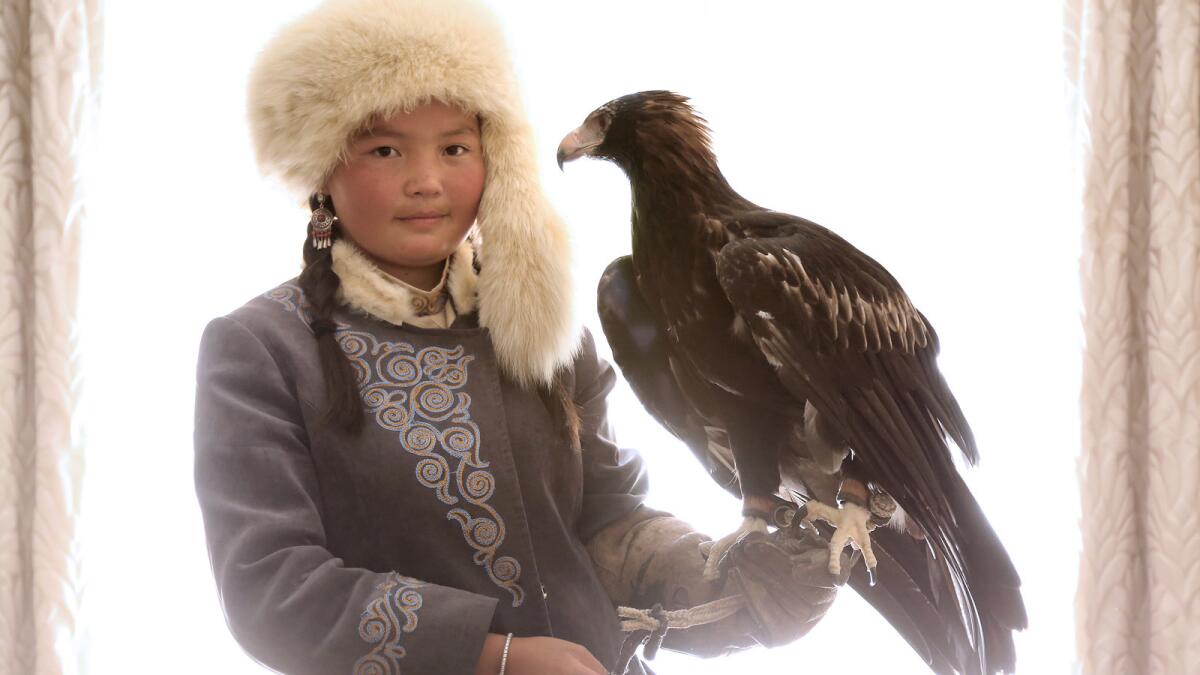In ‘The Eagle Huntress,’ a 13-year-old girl shatters centuries of tradition
In the documentary âThe Eagle Huntress,â Nurgaiv Aisholpan, a 13-year-old Kazakh girl in Mongolia, counters centuries of male-dominated tradition to pursue her dream of participating in the honored ritual of eagle hunting.
Directed by Otto Bell, the film opens Wednesday, nine months after charming critics and audiences at the Sundance Film Festival and gaining celebrity collaborators such as narrator and executive producer Daisy Ridley, executive producer Morgan Spurlock and singer Sia with its tale of female empowerment and visual splendor.
To be clear, eagle hunting is not the hunting of eagles, but rather hunting with eagles, using the majestic birds to catch prey such as rabbits, marmots and foxes. No longer a necessity for survival, the activity is now viewed as a culturally important sport or art form among the people of the Eurasian Steppe.

Twelve generations of Aisholpanâs family have been eagle hunters and her father, Nurgaiv, can name each of the ancestors â all men. Closely related to falconry, which dates back to the third century, eagle hunting is passed down, typically from father to son, among the Kazakh and Kyrgz people. In the 13th century, Mongol emperor Kublai Kahn (grandson of Genghis) reportedly hunted with falconers and eagles. When Mongolia fell under communist rule for most of the 20th century, eagle hunting nearly disappeared, but there has been a revival in recent decades.
In Kazakh, the word for eagle is bĂźrkit and the hunter is called a bĂźrkitshi. The hunters use golden eagles capable of reaching speeds rivaling a Formula I race car. The bĂźrkitshi donât always name their birds, but Aisholpan dubbed hers âWhite Wings.â Ironically in this male-dominated arena, only female eagles are used because they are larger and fiercer, weighing up to 15 pounds with an average height of 3 feet.
At a photo shoot in September in Beverly Hills, an eagle used for film and TV was brought in so that Aisholpan could demonstrate her avian-handling skills. This bird was only 6 pounds, less than half the size of White Wings, who remained back in Mongolia, yet it still looked as though it could soar out the window and easily pluck a poodle off Doheny Drive.
There are six general aspects to eagle hunting: trapping, manning, training, equipment making, competing and the actual hunt. Aisholpan and her father tracked White Wings before capturing it on a precipitous mountain slope, when it was old enough to leave the nest but not strong enough to fully resist.
See the most-read stories in Entertainment this hour Âť
During the manning and training phases, Aisholpan and White Wings bonded, developing the rapport necessary to compete in the annual Golden Eagle Festival. The festival celebrates the long cultural tradition of eagle hunting and provides competition, pitting the bĂźrkitshi and their eagles in various skill tests.
Aisholpan and her parents crafted the needed equipment and winter clothing necessary to brave the elements during the culminating winter hunt. The bĂźrkitshi protects herself by wearing a byalai, a thick leather gauntlet that allows the bird, with its razor-sharp talons, to perch on her arm. A tomagha, or leather hood, keeps the eagle calm and free from distractions. Thin leather straps called jesses are used to tether the bird by its ankle when outside the aviary. On the hunt, the bĂźrkitshi rides horseback with the eagle on her arm, a wooden, Y-shaped baldaq attached to the saddle providing support.
However, the ultimate test is the hunt, in which human and bird trek deep into the mountains and face -40 degree temperatures to measure not only their technical ability, but their mettle and determination. It may take weeks to find prey and successfully conclude the hunt, but in that time, a daughter can prove she is every bit as capable as the many sons that preceded her.
Movie Trailers
More to Read
Only good movies
Get the Indie Focus newsletter, Mark Olsen's weekly guide to the world of cinema.
You may occasionally receive promotional content from the Los Angeles Times.










